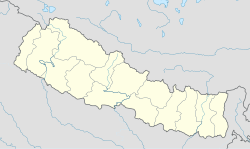Manakamana
| Manakamana | |
|---|---|
 |
|
| Name | |
| Proper name | Manakamana Temple |
| Devanagari | मनकामना मन्दिर |
| Geography | |
| Coordinates | 27°54′16.2″N 84°35′03.3″E / 27.904500°N 84.584250°ECoordinates: 27°54′16.2″N 84°35′03.3″E / 27.904500°N 84.584250°E |
| Country | Nepal |
| District | Gorkha |
| Culture | |
| Primary deity | Hindu Goddess Durga Bhawani, an incarnation of Parvati |
| Architecture | |
| Architectural styles | Pagoda |
| History and governance | |
| Date built | 17th Century |
The Manakamana Temple (Nepali: मनकामना मन्दिर) situated in the Gorkha district of Nepal is the sacred place of the Hindu Goddess Bhagwati, an incarnation of Parvati. The name Manakamana originates from two words, “mana” meaning heart and “kamana” meaning wish. Venerated since the 17th century, it is believed that Goddess Manakamana grants the wishes of all those who make the pilgrimage to her shrine to worship her.
The Manakamana temple lies 12 km south of the town Gorkha. The temple is located on a distinguished ridge 1,302 metres (4,272 ft) above sea level and overlooks the river valleys of Trisuli in the south and Marsyangdi in the west. The spectacular views of the Manaslu- Himachali and Annapurna ranges can be seen to the north of the temple. The temple is approximately a 140 kilometres (87 mi) from Kathmandu and can also be reached via bus east from Pokhara in around three to four hours.
The legend of Manakamana Goddess dates back to the reign of the Gorkha king Ram Shah during the 17th century. It is said that his queen possessed divine powers, which only her devotee Lakhan Thapa knew about. One day, the king witnessed his queen in Goddess incarnation, and Lakhan Thapa in the form of a lion. Upon mentioning the revelation to his queen, a mysterious death befell the king. As per the custom of that time, the queen committed Sati (ritual immolation) on her husband’s funeral pyre. Before, her sati the queen had assured Lakhan Thapa that she would reappear in the near future. Six months later, a farmer while ploughing his fields cleaved a stone. From the stone he saw a stream of blood and milk flow. When Lakhan heard an account of this event, he immediately started performing Hindu tantric rituals at the site where the stone had been discovered thus ceasing the flow of blood and milk. The site became the foundation of the present shrine. According to tradition, the priest at the temple must be a descendent of Lakhan Thapa.
Darshan comes from the Sanskrit word meaning sight. The pilgrimage to Manakamana is made by a great many people every year. This religious expedition to see the Goddess Bhagwati at Manakamana is hence referred to as Manakamana Darshan. According to Hindu mythology the universe is said to consist of five cosmic elements- earth, fire, water, air and ether. The offerings to the Goddess are made on this basis. At least one of the following should be amongst the worship materials:
There is a tradition of sacrificing animals at the temple. Some pilgrims sacrifice goats or pigeons in a pavilion behind the temple. However, recently the District Livestock Service Office, Gorkha has banned the sacrifice of birds such as pigeons, roosters, and ducks to name a few. Senior livestock service officer Chhetra Bahadur K.C. said poultry sacrifice would not be permitted until further notice.
...
Wikipedia

